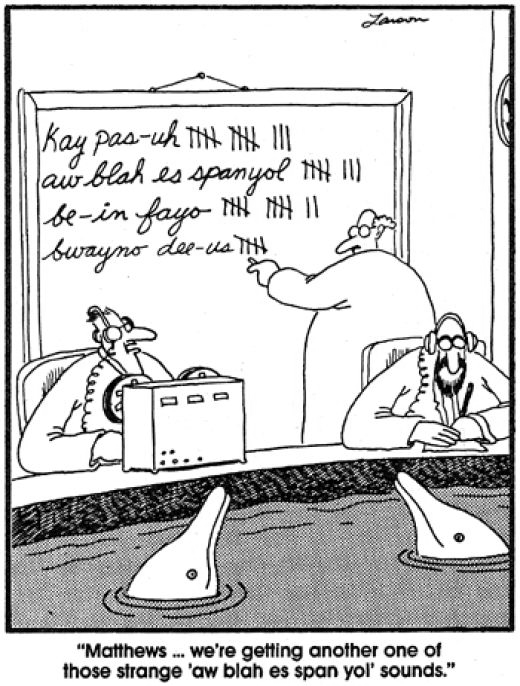
Unit 7-1: What is language?
WRLD 302 - Communicating Across Cultures
This is one in a series of tutorials on intercultural communication. Click on "mobile page" at the bottom of the page for alternative views. You may create a print version by clicking on the "print all" link at the top of the page. Note that additional learning resources are linked in the sidebars.
Anticipated completion time for this tutorial (excluding reading chapter): approximately 110 minutes. Note that you can stop and come back and your score on completed items will be retained.
The objectives below can be achieved through working with the assigned readings, watching the presentations, doing the tutorial exercises, and posting to the discussion forums. Achievement of the objectives will be measured through the score achieved on the exercises (questions can be answered more than once), on the Blackboard quiz for this unit, and on the quality of contributions to the course discussion forums.
By successfully completing this unit, students should be able to...
|
This video excerpt from Outsourced (2006) introduces some of the key issues around language and culture we will be dealing with in the this unit.
|
First, watch the video (about 2 minutes long) below: => YouTube verison |
After watching the video, think about the following:
Now, turn to the next page for comments. |
|
1. What cultures are represented in the clip? The scene takes place in a call center in India, where an American company ("Western Novelty") has just moved its phone sales operation. Todd, the American manager, has been sent over to oversee the operation and eventually transfer management to an Indian. It's evident in the film that Todd has no knowledge of Indian culture. The Indian workers in the call center have more familiarity with American culture in general, but many of the novelty items they are selling are unfamiliar and are often closely linked to aspects of US culture they are not likely to know much about ( backyard barbecue, sports teams, etc.) 2. What problems are the sales representatives having? The company wants to speed up the "MPI" (minutes per incident), i.e. the average call from 12 minutes to six. The whole reason the company is there is to improve their profit margin so greater efficiency is essential. There have also been customer complaints, which according to Todd are due to "a culture thing": "You people need to learn about America". He suggests that they engage in "small talk" to build a relationship with the customer that will put the customer at ease and help the worker learn more about America. One of the topics covered in this chapter will be communication styles - how one uses language in different contexts, which is something that varies across cultures. 3. What does the clip have to say about English as a national language? Todd wants the workers to sound like they are "native English speakers" but the Indians protest that they are native English speakers, However, they speak a different version of English. Indeed, there are a great variety of Englishes and one principal distinction is pronunciation. In linguistics sounds are described using the tools of phonetics/phonology. Linguistics also has a lot to say about how sentences are put together (syntax) and about how words are modified to be used in a variety of ways (wanted to express past tense), which is morphology. English is of course only one of several hundred languages spoken in India. The other official national language is Hindi. There are not only many languages, but they belong to a variety of language families: Indo-European (Hindi, English), Dravidian (Tamil, Telugu), Austro-Asiatic and Tibeto-Burman. 4. Why is it important for Chicago to be pronounced with a nasal twang? What Todd really wants is not just a native English accent, but a pronounced American English accent. There are a variety of accents and dialects in the United States, from Southern twang to Californian valley girl talk. The use of a mid-western accent (not necessarily a Chicago accent) is often seen as "neutral" American English - see the video, "Voice from nowhere" on the Web site, which describes how a woman from Ohio was 5. Besides pronunciation, what other differences are demonstrated in the varieties of English used? There is confusion about the word "rubbers", which in British English means erasers, but has an altogether different, and in this case, unfortunate meaning. The field of linguistics that deals with meaning is semantics. Indian English not only is related to British English phonetically, but also semantically. |
This chapter in the text deals with language, but language can not be separated from culture. We know that Britain and American are "two nations divided by a common language". Both India and the United States use English as an official language but how the language is used varies significantly - in terms of pronunciation (phonetics), vocabulary (semantics) and even grammar (syntax, morphology).
NOTE: You should have read pp. 235-238 in the textbook before watching the presentation.
=> YouTube version
Q1: The power of abstract thought
Q2: Linguistics relativity
NOTE: You should have read pp. 238-247 in the textbook before watching the presentation.
=> View YouTube version
Q4: Descriptive Linguistics
Q5: Smallest unit of meaning
Q6: Universal grammar
Q7: Generative grammar
Q8: Fields in linguistics
For preparing for the on-line quizzes on this material, the publisher Web site can be helpful. It includes Flashcards that cover the key terms listed below. There is also a Web quiz in multiple choice format that would be good practice for our on-line quiz. If you take the practice quiz from the publisher, you don't need to send the results to me (you can email them to yourself instead)
|